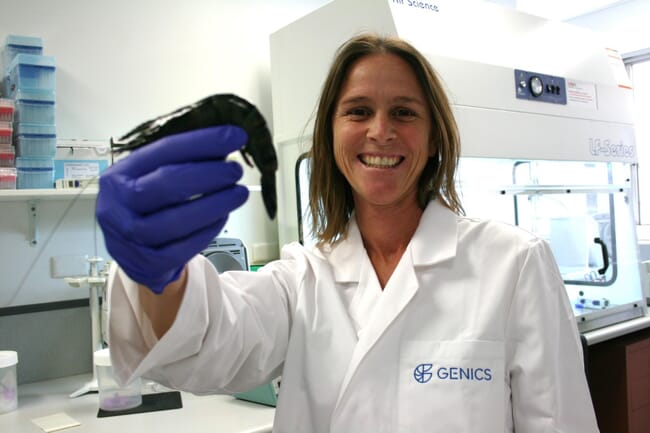
Sellars has been researching and identifying solutions for the global shrimp industry for 20 years
Before founding Genics in 2018, Dr Melony Sellars spent 20 years with the CSIRO, Australia’s federal research body, investigating solutions for the shrimp industry’s biggest challenges. She’s explored the viability of replacing fishmeal in shrimp diets, the husbandry requirements of high-density shrimp production and helped establish commercial breeding programmes across different shrimp species. Sellars has also used genomic tools to help progress genetic selection in shrimp, aid in pathogen diagnostics and develop antivirals and RNAi interferents for shrimp aquaculture. This experience, “allowed me to interact with commercial shrimp producers across the world, letting me understand their biggest challenges and develop solutions that solve their problems,” she says.
Earlier in 2022, Genics developed four new real-time PCR assays that help accurately and reliably detect the presence of decapod iridescent virus in shrimp. After publishing the new pathogen detection methods in the Journal of the World Aquaculture Society, she sat down with The Fish Site to discuss how PCR assays work and the future landscape of pathogen and disease surveillance in shrimp aquaculture.
Pathogen and disease surveillance in shrimp aquaculture
Sellars explains that the shrimp industry started to gain ground before many disease detection strategies were put in place. Shrimp producers quickly learned that there’s a long list of pathogens in the aquaculture environment at any given time – and that upping stocking densities increases the types and amounts of pathogens present in their systems. Disease outbreaks remain one of the biggest challenges in global shrimp aquaculture
– undermining finishing quality and eroding farmer profits.
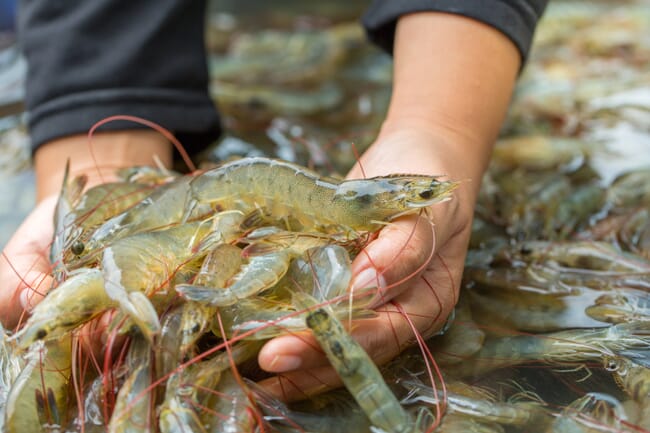
Though bacterial and viral diseases remain a significant challenge, the industry has more tools at its disposal to address outbreaks
However, researchers have made multiple breakthroughs in disease detection and surveillance since the industry’s inception. “We have gained significant understanding of the causative agents of different clinical signs – or sick signs that we see in shrimp,” Sellars says. Fish vets have also learned more about the epidemiology of different shrimp pathogens. Key information on how these viruses, bacteria and fungi behave in the aquaculture environment and how they replicate has been established. This makes it easier to devise detection and treatment protocols.
In addition to these ecological parameters, scientists have learned more about genetic sequencing and its ability to detect the unique DNA signatures of pathogens. Researchers can now use assays – or laboratory procedures that can detect and measure the presence, amount or activity of a target object – to identify the DNA profile of individual pathogens. When these assays piggyback off the polymerase chain reaction (PCR), a chemical reaction that rapidly amplifies the DNA sequence of a tissue sample, researchers can build robust tools that can measure the presence and prevalence of pathogens that cause disease in the aquaculture environment.
Despite this progress, researchers still contend with multiple challenges during pathogen surveillance and when establishing testing systems for novel shrimp pathogens. One is the presence of PCR inhibitors such as chitin – the main component in shrimp exoskeletons – in clinical samples. Chitin can stop a reaction from occurring and results in a false negative in PCR data. To overcome this, researchers need to use additional control PCR assays to ensure that the amount of chitin or other inhibiting material in the sample is not preventing the PCR reaction.
“There are very few laboratories and very few testing platforms that actually have controls for each and every sample that is extracted,” Sellars explains. If these quality controls lapse, farmers may be given false negatives – hamstringing their next steps when addressing the disease outbreak.
Accounting for these testing requirements can get expensive, so researchers are devising ways to keep pathogen detection financially viable for shrimp farmers. Sellars says that the team at Genics have successfully paired pathogen and control detection assays together in a single test. This “multiplexed” approach – where single tests can detect multiple target pathogens in one reaction – can turn what would be two or more reactions into fewer or one reaction.
Another considerable challenge when developing new pathogen assays is gaining access to samples of shrimp that are infected with the pathogen of interest. Samples from clinically diseased shrimp are essential for developing and validating new assays. Sellars says that researchers need hundreds of samples of pathogen-infected shrimp from different culture systems to fully validate one assay.
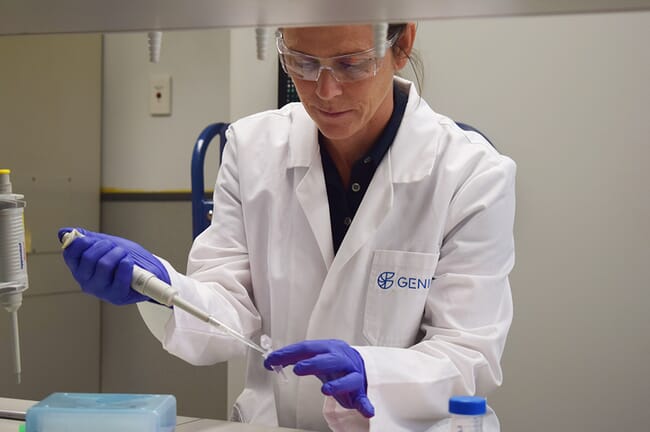
Dr Sellars and her team wanted to design a practical tool that could detect the presence of multiple pathogens in a tissue sample
The fact that multiple pathogens are present in the aquaculture environment is another hurdle. Shrimp can be infected with as many as four different pathogens at any one time – since there is a long list of endemic pathogens in shrimp farming regions, producers can never be sure which pathogen is in their ponds. This has meant that very few farmers were testing for the full range of pathogens that could be present in their animals – mainly due to cost constraints. This gave them a partial picture of their situation and many producers made key farm decisions based on fragmented data.
Sellars says that the shrimp industry needs access to practical tools that can accurately and reliably detect the presence of multiple pathogens in a tissue sample. Creating and commercialising these tools would ensure that the shrimp industry stays ahead of disease outbreaks and can track the low-level presence and prevalence of pathogens in culture systems, predicting and mitigating disease risks.
The emergence of decapod iridescent virus (DIV1)
Novel decapod iridescent virus infections were first identified in mainland China in 2014 and have devastated multiple shrimp operations along the Chinese coast. DIV1 infections target the tissues where blood and immune cells are formed, the gills and hepatopancreatic sinuses. DIV1 infections in penaeid shrimp can present clinical signs like softened shells, hepatopancreas atrophy with pale or yellowish discoloration and an empty stomach and midgut. Some dying shrimp have shown a slightly whiteish colouration of the abdominal muscle. Farmers and researchers noticed shockingly high mortality rates in DIV1-infected shrimp, leading to calls for better detection and treatment methods for the virus.
Since it was first identified and sequenced, the virus remains a critical emerging pathogen threat for the global shrimp industry. In 2020, DIV1 was detected in Taiwan and undermined the island’s crayfish and shrimp industries. Since that outbreak, researchers have identified the virus in wild-caught shrimp broodstock specimens from the Indian Ocean – even though the animals weren’t exhibiting any clinical signs of disease. This is raising concerns that prawns may become a host for DIV1, facilitating its spread across the Asia-Pacific region and allowing the virus to become further entrenched.
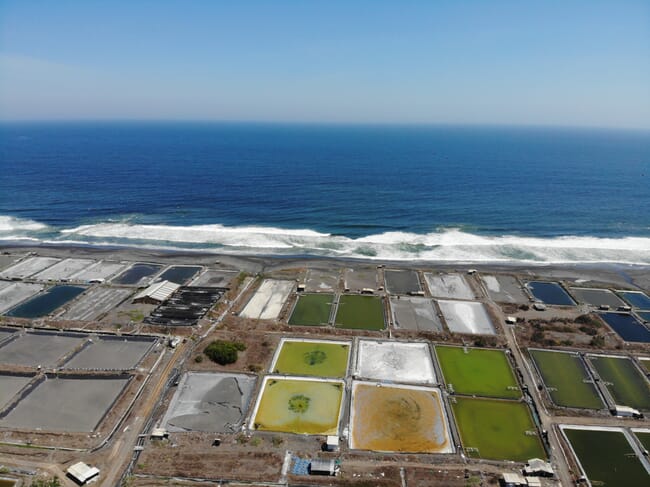
Since shrimp ponds can contain multiple pathogens at any given time, maintaining biosecurity protocols is essential © Alune
In her fieldwork with Genics, Sellars noticed that the PCR assays published for DIV1 had some performance limitations. Some of this could be down to the virus’s novelty – it was only detected and sequenced eight years ago. “The available assays showed issues with their primers forming what are called primer dimers, where they stick together and can’t work properly, and others had issues with specificity in certain instances,” she explains.
Sellars tells The Fish Site that the company got lucky when they gained access to a shrimp farm that was reporting significant mortalities in its ponds and hadn’t identified the causative agent. The farm was willing to submit samples of shrimp tissue for research and development purposes.
The team at Genics excluded all other possible known pathogens, but were able to amplify decapod iridescent virus during their investigation. The team decided to focus their research efforts on developing new – and more accurate – assays for DIV1. To do this, the Genics team needed to identify and isolate alternative target genes for the virus. Sellars and her team extracted additional viral DNA samples from the DIV1-affected ponds, curating a broader base of viral genetic material. After sequencing it, she and her team had a more complete template to work with. They were one step closer to designing a new pathogen detection platform.
Developing a new PCR assay for DIV1
PCR, or the polymerase chain reaction is a method that creates thousands of copies of a fragment or strand of DNA. The assay for DIV1 – or method of initiating and regulating the reaction to detect the virus, was what Sellars wanted to perfect.
“PCR assays work in a range of different ways, but typically, they all start out with a DNA (or RNA) extraction process, followed by an amplification process with what are known as primers,” Sellars says. The primers usually contain between 21 and 24 base pairs of DNA – the As, Ts, Gs and Cs that make up the double-strands of DNA. If a target virus is present in a sample, the genetic base pairs of the primer “sit down” on the virus’s genetic code in a sequence-specific way – “one sits down on the left and one sits down on the right,” Sellars says.
After putting the DNA sample on a PCR reaction plate, researchers add an enzyme and reagents to the sample that allows the primers to create short strands of “synthetic” DNA identical to the pathogen of interest. Once these strands are created through multiple heating and cooling cycles in a PCR machine or thermocycler, they can be visualised in different ways on specialised equipment.
“That’s the general overview, but there are more sophisticated systems like two-step or nested PCR tests, real-time PCR or MultiPath PCR that incorporate multiple primers and fluorescent dyes in the replicated DNA,” Sellars explains.
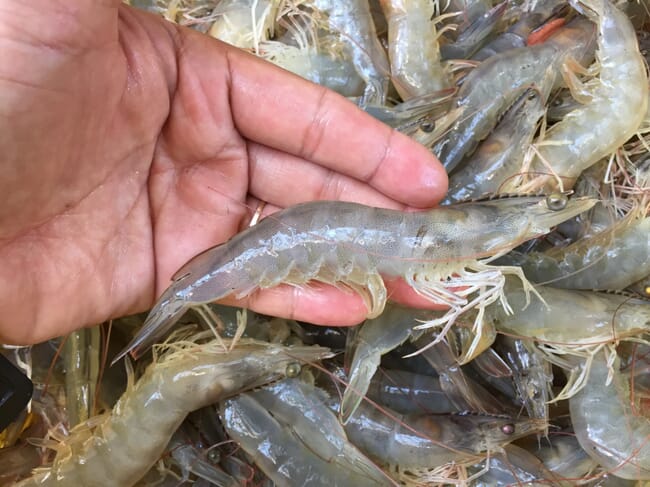
Sellars and her team were able to identify and isolate alternative target genes for DIV1 and develop new assays
For her work with DIV1, Sellars decided to design an assay for a real-time PCR test that used a combination of primer pairs and probing pairs on a high-density reaction plate. “The additional probes allow you to take advantage of increased sensitivity and increased specificity of the assays,” she says. Taking this approach allowed her to include multiple assays in a single test, letting farmers and researchers gain results that were accurate and specific for DIV1.
The importance of new PCR assays for DIV1
Sellars says that the assays are contributing to practical and cost-effective disease surveillance for DIV1. When viewed in a broader sense, it gives the industry access to more monitoring tools and can be the first step in creating an early disease warning system for shrimp farmers. Sellars points out that if farmers are armed with this information, they can deploy risk mitigation protocols to keep disease outbreaks at bay. The new assays are laying a key foundation for increasing biosecurity preparedness in shrimp aquaculture.
What’s next in disease detection?
According to Sellars, the industry will likely move away from point-of-care testing when it comes to detecting diseases. “Point of care testing is excellent for confirming that we have sick animals,” she says. Instead, the industry will likely adopt technologies that can detect the presence of pathogens weeks before producers notice clinical signs of disease or sickness in their shrimp. Shifting the goalposts from identifying a pathogen mid-outbreak to detecting their early presence and prevalence, in combination with adequate management decisions, will prevent mortalities and make farms more profitable. Once this happens, “farmers can have an early warning system weeks before they have sick shrimp and weeks before they have disease in their animals,” Sellars says.
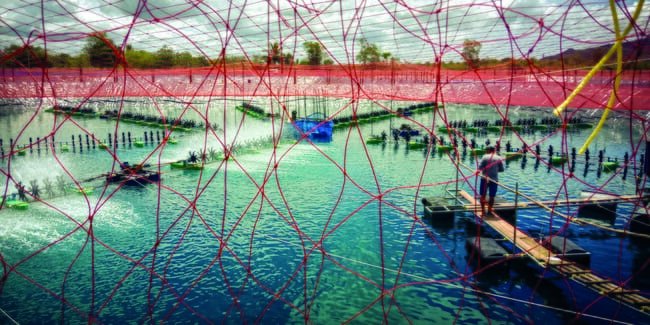
Sellars believes that the shrimp industry will adopt technologies that will detect pathogens before shrimp become sick © FAI
“I see an industry where we all work towards early pathogen detection, early disease mitigation and where we work to reduce the spread of pathogens in our ponds, within our farm sites… and within the areas where we produce shrimp.”
Keeping an eye on stocking densities
Though early pathogen detection will be a gamechanger for shrimp aquaculture, Sellars sees one outstanding challenge on the horizon: stocking densities. Shrimp farmers have plenty of economic and environmental incentives to intensify their farm outputs and up their production densities, but producing more shrimp in a smaller land area increases the prevalence of pathogens in the farm environment.
Sellars says that the industry must start producing robust shrimp with high health performance that can thrive in intensive farming conditions. She also points out that environmentally sustainable production methods, like recirculating aquaculture systems (RAS), need to keep shrimp health front of mind as well.
“With RAS comes considerable challenges with pathogens, especially bacterial infections – recirculating systems can spread pathogens rapidly. This can be catastrophic when the systems are run at high densities,” she explained. As more shrimp producers opt for recirculating systems, early disease detection will become a routine requirement.
“The shrimp industry needs to come up with ways that better manage the risk of disease and improve their methods for identifying and understanding those risks early in production – before shrimp exhibit clinical signs of disease or experience mortalities,” Sellars concludes.
Read the full paper in the Journal of the World Aquaculture Society.




